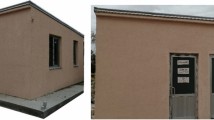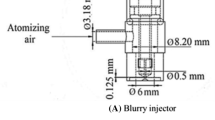Abstract
The effects of multi-walled carbon nanotubes (MWNTs) on flame spread over liquid fuels and its mechanisms are investigated in this work. MWNTs have shown a significant flame retarding behavior and are applied as flame retardant additives to increase fire safety. We measured the duration of flame spread over trays filled with diesel oil, kerosene or their mixtures with different concentrations of MWNTs. The results show the significant retardation of flame spread by addition of MWNTs. Comparing the results in copper and steel trays revealed that for 1 g/l of MWNTs, increasing the thermal conductivity of fuel is the dominant flame retarding mechanism, and retardation by disrupting the convective flows in the fuel is negligible. Nevertheless, for higher concentrations of nanotubes, disrupting the convective flows is also an important mechanism of flame spread retardation.





Similar content being viewed by others
References
Glassman I, Dryer FL (1981) Flame spread across liquid fuels. Fire Saf J 3:123–138
Olson SL (2011) Piloted ignition delay times of opposed and concurrent flame spread over a thermally-thin fuel in a forced convective microgravity environment. Proc Combust Inst 33:2633–2639
Olson SL, Miller FJ, Jahangirian S, Wichman IS (2009) Flame spread over thin fuels in actual and simulated microgravity conditions. Combust Flame 156:1214–1226
Takahashi K, Ito A, Kudo Y, Konishi T, Saito K (2008) Scaling analysis on pulsating flame spread over liquids. Int J Chem Eng 2008 1 10
Takahashi K, Kodaira Y, Kudo Y, Ito A, Saito K (2007) Effect of oxygen on flame spread over liquids. Proc Combust Inst 31:2625–2631
Takahashi K, Ito A, Kudo Y, Konishi T, Saito K (2005) Scaling and instability analyses on flame spread over liquids. Proc Combust Inst 30:2271–2277
Shaw A, Epling W, McKenna C, Weckman B (2010) Evaluation of the ignition of diesel fuels on hot surfaces. Fire Technol 46(2):407–423
Colwell JD, Reza A (2005) Hot surface ignition of automotive and aviation fluids. Fire Technol 41(2):105–123
Zanganeh J, Moghtaderi B (2013) Effect of fuel soaked time and fuel ratio on the flame spread rate over a porous bed wetted with liquid fuel. Fire Saf J 59:151–159
Zanganeh J, Moghtaderi B (2013) Experimental and mathematical analysis of fuel penetration through unconsolidated porous media. J Fire Mater 37(2):160–170
Zanganeh J, Moghtaderi B, Ishida H (2013) Combustion and flame spread on fuel-soaked porous solids. Prog Energy Combust Sci 39:320–339
Zanganeh J, Moghtaderi B (2011) Flame spread over porous sand beds wetted with propanol. J Fire Mater 35(2):61–70
Zanganeh J, Moghtaderi B (2010) Experimental study of temperature distribution and flame spread over an inert porous bed wetted with liquid fuel. Int J Emerg Multidiscip Fluid Sci 2(1):1–14
Olenick SM, Klassen MS, Roby RJ, Ma T, Torero JL (2010) The behavior of liquid fuel on carpet (porous media): a case for the inclusion of science in fire investigation. Fire Technol 6(4):843–852
Korzhavin AA, Bunev VA, Babkin VS, Namyatov IG (2012) Effect of initial temperature on the velocity of flame spread. Combust Explos Shock Waves 48(5):570–578
Guo J, Lu S, Li M, Wang C (2011) Flame spread over aviation kerosene with an obstacle in liquid phase. J Therm Sci 20(6):543–547
Zhou J, Chen G, Li P, Chen B, Wang C (2009) Analysis of flame spread over aviation kerosene. Chin Sci Bull 55(17):1822–1827
Zamashchikov VV (2009) Effect of modulations of opposed gas flow velocity on flame spread rate over a liquid surface. Combust Explos Shock Waves 45(1):8–13
Korzhavin AA, Bunev VA, Namyatov IG, Babkin VS (2000) Flame spread over liquid fuel films on metallic substrates. Combust Explos Shock Waves 36(3):304–309
Lu H, Wilkie CA (2010) Synergistic effect of carbon nanotubes and decabromodiphenyl oxide/Sb2O3 in improving the flame retardancy of polystyrene. Polym Degrad Stab 95:564–571
Cipiriano BH, Kashiwagi T, Raghavan SR, Yang Y, Grulke EA, Yamamot K, Shields JR, Douglas JF (2007) Effects of aspect ratio of MWNT on the flammability properties of polymer nanocomposites. Polymer 48:6086–6096
Peeterbroeck S, Laoutid F, Taulemesse JM, Monteverde F, Lopez-Cuesta JM, Nagy JB, Alexandre M, Dubois P (2007) Mechanical properties and flame-retardant behavior of ethylene vinyl acetate/high-density polyethylene coated carbon nanotube nanocomposites. Adv Funct Mater 17:2787–2791
Hassan MI, Grulke E, Chuah K, Saito K (2005) Effects of carbon nanotubes on flame spread rate over 1-propanol. Fire Saf J 40:425–438
Nakakuki A (1993) Heat transfer mechanisms in liquid pool fires. Fire Saf J 23:339–363
Ito A, Masuda D, Saito K (1991) A study of flame spread over alcohols using holographic interferometry. Combust Flame 83:375–389
ASTM D 56 (2002) Standard test method for flash point by tag closed cup tester. ASTM International, West Conshohocken
Zamashchikov VV (2008) Flame spread over a liquid surface in a channel of finite section under oncoming air-flow conditions. Combust Explos Shock Waves 44(1):25–30
Halelfadl S, Estellé P, Aladag B, Doner N, Maré T (2013) Viscosity of carbon nanotubes water based nanofluids: Influence of concentration and temperature. Int J Therm Sci 71:111–117
Dalkilic AS, Kayac N, Celen A, Tabatabaei M, Yıldız O, Daungthongsuk W, Wongwises S (2012) Forced convective heat transfer of nanofluids—a review of the recent literature. Curr Nanosci 8:949–969
Author information
Authors and Affiliations
Corresponding author
Rights and permissions
About this article
Cite this article
Alibakhshi, A., Mirshahvalad, H. & Alibakhshi, S. Investigating the Mechanism of Effect of Carbon Nanotubes on Flame Spread Over Liquid Fuels. Fire Technol 51, 759–770 (2015). https://doi.org/10.1007/s10694-014-0392-7
Received:
Accepted:
Published:
Issue Date:
DOI: https://doi.org/10.1007/s10694-014-0392-7




